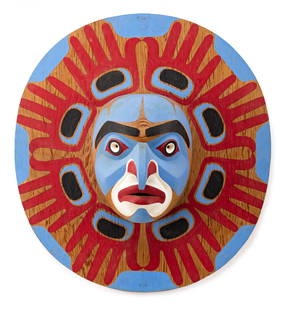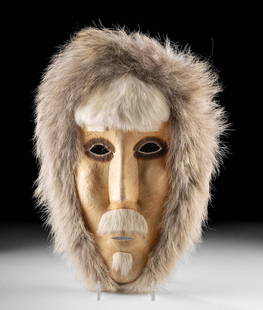
MUNGO MARTIN, FIRST NATIONS, Mask , c. 1950
Similar Sale History
View More Items in Masks
Related Masks
More Items in Masks
View MoreRecommended Art
View More




Item Details
Description
Lot 53
MUNGO MARTIN (NAKAPANKAM) (c. 1879-1962) KWAKWA̱KA̱ʼWAKW
Mask, c. 1950
wood and pigment, 7.5 x 6.25 x 4 in (19.1 x 15.9 x 10.2 cm)
with partial signature, "ngo";
inscribed indistinctly in graphite in an unknown hand, "1950 [?]'
Provenance
Private Collection, Calgary.
Mungo Martin was amongst the most historically significant Northwest Coast First Nations artists of the 20th century. The stepson and apprentice of renowned Kwakwaka'wakw carver Yakudlas Charlie James (1867–1938) and uncle of Ellen Neel (1916 –1966), Martin was an important, early teacher to several prominent artists including Henry Hunt (1923 –1985) and Doug Cranmer (1927 – 2006). Working throughout and in spite of the potlatch ban, Martin’s name is synonymous with the mid-20th century revitalization of Northwest Coast art, and he is often credited with bridging the cultural and artistic practices of the 19th century with the reappraisal of Northwest Coast as fine art in the second half of the 20th century. In addition to his work as an artist, Martin collaborated on various projects with anthropologists such as Marius Barbeau, Wilson Duff, Ida Halpern, and Audrey and Harry Hawthorn. Martin worked for the Museum of Anthropology (MOA) from 1949 to 1952 and at the Royal British Columbia Museum (RBCM) throughout the 1950s, recreating and restoring totem poles on-site and connecting institutions and curators with communities and objects. [1] The MOA especially benefitted from this relationship, noting in Martin’s biography that he “[recorded] his personal knowledge about Kwakwaka’wakw histories and songs, and encouraged community members to sell their regalia to the Museum. The resulting collection is unique for its direct ties to families who hold ongoing rights to the privileges represented.” [2] Martin also hosted the first public, legal potlatch of the 20th century in 1953, two years after the lifting of the potlatch ban in 1951. [3].
This human mask by Mungo Martin is a fine example of his later work that features simplified, bold designs and a desirable white undercoat of paint. While Martin’s early work was nearly indistinguishable from that of his stepfather Charlie James, his later pieces became bolder, more simplified, and experimental in terms of the colours he was using (such as the mint green found on this mask). The style of this mask has a certain affinity to Ellen Neel, as well, and shows the influence that Martin had on her work. An important feature of Martin’s style that distinguishes his work from other makers is the way he used internally tangent circles to form his eyes, creating a certain “cross-eyed” expression that can be seen on this mask and on other pieces in the collections of the RBCM (objects 6442, 6443, and 6444) and MOA (2778/1 a-b). There is a partial signature of “ngo” on this mask and a date of 1950, perhaps indicating that this mask was carved while Martin was employed at the Museum of Anthropology in Vancouver.
[1] Glass, Aaron. 2006. "From Cultural Salvage to Brokerage: The Mythologization of Mungo Martin and the Emergence of Northwest Coast Art." Museum Anthropology 29 (1): 20-43. [2] “Mungo Martin (c. 1879 - 1962) Biography,” Museum of Anthropology at UBC, accessed April 23, 2023, [3] Hawker, Ronald. 2002. Tales of Ghosts: First Nations Art in British Columbia, 1922-61. Vancouver: UBC Press.
Christopher W. Smith
References: For additional information on Martin’s contributions to the anthropologists at UBC, see Aaron Glass, 2006, "From Cultural Salvage to Brokerage: The Mythologization of Mungo Martin and the Emergence of Northwest Coast Art." Museum Anthropology 29 (1): 20-43. For Mungo Martin’s role in potlatch at UBC in 1953, see Richard Hawker, Tales of Ghosts: First Nations Art in British Columbia, 1922-61, (Vancouver: UNC Press, 2003), pp.127-142. See also Phil Nuytten, The Totem Carvers: Charlie James, Ellen Neel, Mungo Martin, (Vancouver: Panorama Pres, Ltd., 1982), pp. 75-109. For additional information on Mungo Martin’s UBC restoration project, see the photo essay “Totem Pole Carver” by Audrey Hawthorn, The Beaver, March 1952, pp. 3-6. For an unpainted Echo Mask by the artist, see First Arts, 5 December 2022, Lot 137. See also Elizabeth Kirk, Tradition & Change on the Northwest Coast: The Makah, Nuu-chah-nulth, southern Kwakiutl and Nuxalk, (Seattle, WA: University of Washington Press, 1986), pp. 27-29.
MUNGO MARTIN (NAKAPANKAM) (c. 1879-1962) KWAKWA̱KA̱ʼWAKW
Mask, c. 1950
wood and pigment, 7.5 x 6.25 x 4 in (19.1 x 15.9 x 10.2 cm)
with partial signature, "ngo";
inscribed indistinctly in graphite in an unknown hand, "1950 [?]'
Provenance
Private Collection, Calgary.
Mungo Martin was amongst the most historically significant Northwest Coast First Nations artists of the 20th century. The stepson and apprentice of renowned Kwakwaka'wakw carver Yakudlas Charlie James (1867–1938) and uncle of Ellen Neel (1916 –1966), Martin was an important, early teacher to several prominent artists including Henry Hunt (1923 –1985) and Doug Cranmer (1927 – 2006). Working throughout and in spite of the potlatch ban, Martin’s name is synonymous with the mid-20th century revitalization of Northwest Coast art, and he is often credited with bridging the cultural and artistic practices of the 19th century with the reappraisal of Northwest Coast as fine art in the second half of the 20th century. In addition to his work as an artist, Martin collaborated on various projects with anthropologists such as Marius Barbeau, Wilson Duff, Ida Halpern, and Audrey and Harry Hawthorn. Martin worked for the Museum of Anthropology (MOA) from 1949 to 1952 and at the Royal British Columbia Museum (RBCM) throughout the 1950s, recreating and restoring totem poles on-site and connecting institutions and curators with communities and objects. [1] The MOA especially benefitted from this relationship, noting in Martin’s biography that he “[recorded] his personal knowledge about Kwakwaka’wakw histories and songs, and encouraged community members to sell their regalia to the Museum. The resulting collection is unique for its direct ties to families who hold ongoing rights to the privileges represented.” [2] Martin also hosted the first public, legal potlatch of the 20th century in 1953, two years after the lifting of the potlatch ban in 1951. [3].
This human mask by Mungo Martin is a fine example of his later work that features simplified, bold designs and a desirable white undercoat of paint. While Martin’s early work was nearly indistinguishable from that of his stepfather Charlie James, his later pieces became bolder, more simplified, and experimental in terms of the colours he was using (such as the mint green found on this mask). The style of this mask has a certain affinity to Ellen Neel, as well, and shows the influence that Martin had on her work. An important feature of Martin’s style that distinguishes his work from other makers is the way he used internally tangent circles to form his eyes, creating a certain “cross-eyed” expression that can be seen on this mask and on other pieces in the collections of the RBCM (objects 6442, 6443, and 6444) and MOA (2778/1 a-b). There is a partial signature of “ngo” on this mask and a date of 1950, perhaps indicating that this mask was carved while Martin was employed at the Museum of Anthropology in Vancouver.
[1] Glass, Aaron. 2006. "From Cultural Salvage to Brokerage: The Mythologization of Mungo Martin and the Emergence of Northwest Coast Art." Museum Anthropology 29 (1): 20-43. [2] “Mungo Martin (c. 1879 - 1962) Biography,” Museum of Anthropology at UBC, accessed April 23, 2023, [3] Hawker, Ronald. 2002. Tales of Ghosts: First Nations Art in British Columbia, 1922-61. Vancouver: UBC Press.
Christopher W. Smith
References: For additional information on Martin’s contributions to the anthropologists at UBC, see Aaron Glass, 2006, "From Cultural Salvage to Brokerage: The Mythologization of Mungo Martin and the Emergence of Northwest Coast Art." Museum Anthropology 29 (1): 20-43. For Mungo Martin’s role in potlatch at UBC in 1953, see Richard Hawker, Tales of Ghosts: First Nations Art in British Columbia, 1922-61, (Vancouver: UNC Press, 2003), pp.127-142. See also Phil Nuytten, The Totem Carvers: Charlie James, Ellen Neel, Mungo Martin, (Vancouver: Panorama Pres, Ltd., 1982), pp. 75-109. For additional information on Mungo Martin’s UBC restoration project, see the photo essay “Totem Pole Carver” by Audrey Hawthorn, The Beaver, March 1952, pp. 3-6. For an unpainted Echo Mask by the artist, see First Arts, 5 December 2022, Lot 137. See also Elizabeth Kirk, Tradition & Change on the Northwest Coast: The Makah, Nuu-chah-nulth, southern Kwakiutl and Nuxalk, (Seattle, WA: University of Washington Press, 1986), pp. 27-29.
Condition
The absence of condition does not imply that an item is free from defects, nor does a reference to particular defects imply the absence of any others. Our team can provide thorough and comprehensive condition reports and additional images. We welcome your enquiries at info@firstarts.ca or 647-286-5012.
NOTE
Many countries prohibit or restrict importation or exportation of property containing ivory, whale bone, sealskin, and/or products derived from other endangered or protected species, and require special licenses or permits in order to import or export such property. It is the responsibility of the buyer to ensure that the item is properly and lawfully exported / imported.
NOTE
Many countries prohibit or restrict importation or exportation of property containing ivory, whale bone, sealskin, and/or products derived from other endangered or protected species, and require special licenses or permits in order to import or export such property. It is the responsibility of the buyer to ensure that the item is properly and lawfully exported / imported.
Buyer's Premium
- 23%
MUNGO MARTIN, FIRST NATIONS, Mask , c. 1950
Estimate CA$8,000 - CA$12,000
10 bidders are watching this item.
Shipping & Pickup Options
Item located in Toronto, ON, caSee Policy for Shipping
Local Pickup Available
Payment

Related Searches
TOP













































































